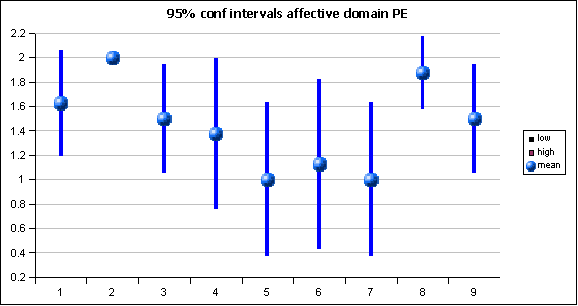SLO Revolution VIII
Exercise Sport Science program and course affective domain student learning outcomes assessment
The Exercise Sport Science program has one affective domain student learning outcome:
Students will value physical activity and its contribution to a healthful lifestyle.
The PE 101j Joggling course has an affective domain student learning outcome identical to the above:
Students will value physical activity and its contribution to a healthful lifestyle .
The course also has a second student learning outcome currently listed as a course intention:
Students will have an opportunity to experience the joys of aerobic exercise: the feelings of strength, energy, and stress release.
At the time I realized that though I might not intend to measure the outcomes, there was a path by which indirect evidence of the outcome could be obtained. This term I tackled gaining this knowledge with a Likert survey. The students answered nine questions:
- I enjoyed participating in the physical activities of this class.
- Physical fitness is important to my present and future lifestyle.
- Exercise and physical fitness is an important part of my college experience.
- I have enjoyed participating in Joggling class.
- I feel I am more fit as a result of this class.
- Because of the skills I have gained in this class, I would like to continue running in the future.
- This class has improved my attitude towards the sport of running.
- I had fun in this class.
- I feel I have experienced the joy of aerobic exercise: the feelings of strength, energy, and stress release.
The students were offered the following choices: strongly disagree, disagree, maybe, agree, strongly agree. The five options were assigned the following values:
Strongly disagree: -2
Disagree: -1
Maybe: 0
Agree: 1
Strongly agree: 2
The results for the eight students in the class were as follows:
| Num |
Question |
s1 |
s2 |
s3 |
s4 |
s5 |
s6 |
s7 |
s8 |
| 1 |
I enjoyed participating in the physical activities of this class. |
1 |
1 |
2 |
1 |
2 |
2 |
2 |
2 |
| 2 |
Physical fitness is important to my present and future lifestyle. |
2 |
2 |
2 |
2 |
2 |
2 |
2 |
2 |
| 3 |
Exercise and physical fitness is an important part of my college experience. |
1 |
2 |
2 |
1 |
1 |
2 |
2 |
1 |
| 4 |
I have enjoyed participating in Joggling class. |
2 |
2 |
2 |
0 |
1 |
1 |
2 |
1 |
| 5 |
I feel I am more fit as a result of this class. |
0 |
2 |
1 |
0 |
1 |
1 |
2 |
1 |
| 6 |
Because of the skills I have gained in this class, I would like to continue running in the future. |
2 |
2 |
1 |
0 |
1 |
1 |
2 |
0 |
| 7 |
This class has improved my attitude towards the sport of running. |
1 |
1 |
0 |
1 |
1 |
2 |
2 |
0 |
| 8 |
I had fun in this class. |
2 |
2 |
2 |
1 |
2 |
2 |
2 |
2 |
| 9 |
I feel I have experienced the joy of aerobic exercise: the feelings of strength, energy, and stress release. |
2 |
1 |
1 |
1 |
2 |
1 |
2 |
2 |
There was no disagreement with any of the statements. The 95% confidence intervals were calculated for each question: any question that crosses y = 0 would be deemed statistically indistinguishable from "maybe." Although the sample size is small, the number exceeds the minimum of five for calculating a confidence interval. The chart below has the question number on the horizontal or x-axis. The ball is at the mean or average, the blue bar is the extent of the 95% confidence interval. Number two had no variation, hence the lack of a 95% confidence interval.

Questions two and eight generated the strongest agreement. The students conceive that physical fitness is important and they had fun. The answer to question two was unanimous strong agreement. The students value that which the program learning outcome indicates they are to value as a result of the program: physical activity and its contribution to a healthful lifestyle .
Number nine directly asked whether the student learning outcome that was couched as a course intention was accomplished. The 1.5 average and a confidence interval that is wholly above 1 indicates moderately strong agreement. This outcome can be measured and can be reported upon, even though it was this very outcome that generated the most flak in the fall of 2002.
Thus we can measure what we expect students to do, know, and value.
To read any of the tome of reports done last fall on student learning outcomes, please turn to:
Dana Lee Ling
